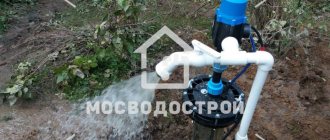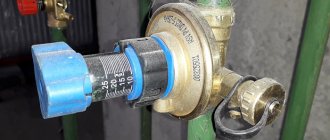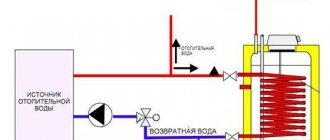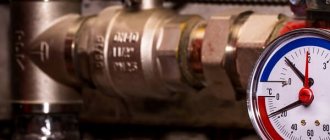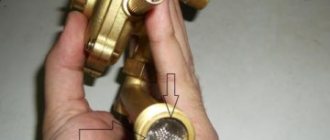A grease trap is a device in which running fatty water removes 80-90% of fat. After which, “clean water” goes by gravity into the sewer. The accumulated layer of fat must be periodically removed and disposed of. The simplest device reduces the cost of cleaning sewer pipes that are prone to clogging with fatty deposits.
Modern equipment options differ in the material from which they are made, the shape of the body and the internal design. In each case, only the principle of operation remains unchanged: at the entrance to the grease trap, the flow loses its pressure; in a calm environment, light fat floats and accumulates on the surface of the water, and heavy particles of debris settle to the bottom; the purified liquid flows through the outlet pipe into the sewer.
A clear example of the operation of the most common scheme for purifying fatty water is presented in the video:
The purpose of the article: to compile a rating of existing models of grease traps, which will introduce the user to the features and potential of devices presented on the domestic market of cleaning equipment.
Installation of a grease trap is advisable in the following conditions:
- processing and production shops of food industry enterprises;
- catering units at catering facilities;
- kitchens of a private household, in the presence of hidden sections of the sewer system, more than 5 meters long.
That is, when, in order to clean pipes clogged with grease, you are forced to stop the work process for an indefinite period or involve specialists with highly specialized equipment.
Main technical characteristics of grease traps
| Characteristic | Characteristics indicator | Device Terms of Use |
| Capacity, m³/h ( throughput at which the device cleans the drain with declared efficiency ) | 0.3 – 0.5 | Kitchen of a private house. |
| 0.5 – 1.5 | Food service area of a bar, cafe, restaurant. | |
| more than 1.5 | Processing and production workshops of food industry enterprises. | |
| Peak discharge, l ( capacity limit at which complete drainage of water from connected devices is ensured ). | up to 40 | Suitable for 1-2 sinks, household dishwasher. |
| 40 — 200 | Optimal for cleaning drains from washing baths and industrial dishwashers. | |
| over 200 | For cleaning wastewater from digesters, food warmers, sinks and dishwashers - workshop equipment of catering establishments. | |
| Principle of operation | Gravitational | Fat is loose and lighter than water, so in an environment without flow it collects on top, and the denser and heavier liquid remains at the bottom. |
| Aerobic | Water purification from fatty particles is carried out by microorganisms. | |
| Maximum weight of the connected device, kg | up to 50 | Household equipment, suitable for installation under the kitchen sink in the cabinet of a furniture set. |
| 50-200 | Devices for servicing catering units of various capacities. Rigid fixation of the equipment is shown. | |
| from 200 | Industrial equipment. A prepared site (frame, foundation) is required for installation. |
For all types of equipment, long (at least 15 years) service life is stated, due to the simplicity of the design and the use of wear-resistant materials (plastic, stainless steel).
Model summary table
| Model | Peculiarity | Approximate price |
| For household use | ||
| 1. Onyx 0.5-15 | A compact device that will find a place even in the smallest kitchen. | 7 000 |
| 2. Biofor 0.5-40 “pro” | A small device mounted under the sink. You can connect a kitchen sink and a household dishwasher at the same time. | 5 450 |
| For servicing drainage from catering equipment | ||
| 3. Termite 1.0-60 | Lightweight and durable plastic housing for easy maintenance of the device. | 6 500 |
| 4. EVO STOK 1.0-70 | The most comfortable way to collect and dispose of garbage. | 10 577 |
| 5. PE 1.5-100 auto collection | There is no need to check the container daily - the fat is removed automatically. | 37 050 |
| For large volumes of wastewater | ||
| 6. KS-Zh-2V | High-performance, well version for installation outside the building. | 45 000 |
| 7. ACO Lipator | A workshop autonomous unit that pumps separation products into a separate container. | 3 353 808 |
Design and principle of operation of the grease trap
Every household must have an effective device for cleaning the drainage system, but if such a device has to be used regularly, it is easier to prevent sewer clogging. To do this, household grease traps are installed under the sink and sink.
The design of these devices is very elementary. The device consists of a housing with a partition that divides it into compartments, a flow damper and a gas outlet pipe with ventilation. Depending on the purpose and amount of wastewater, equipment can have various parameters and vary in design.
The operating principle is based on the difference in density between water and fat. When the liquid cools, the fat also cools, rising to the surface in the form of lumps. The liquid medium enters the next compartment, and then into the sewer and drain. The fat remains in the first compartment thanks to the partition. When the tank is full, the grease traps must be cleared of the mass of fat, then the device is reconnected to the system for subsequent operation.
The cleaning procedure depends on the type and volume of the model. Household separators are easy to clean with your own hands, but dirt from large containers must be pumped out using pumps.
Features of the grease separator
Operating principle and differences between models
So, as mentioned above, there are two types of grease traps:
- Industrial.
- Household.
The latter are a small septic tank, which is located under the sink. During the process of cooking and washing dishes, the device takes over primary wastewater, cleaning it from grease.
In the photo - an industrial grease trap
This septic tank works on the principle of a septic tank. As a rule, it is a rectangular container, inside of which there are partitions that divide the space into several chambers. Since fat particles are much lighter than water, they are retained in a special settling chamber, and the water freely flows into the sewer.
It should be noted that household grease traps come in two types:
| Autonomous | The device does not require an electrical connection to operate. |
| Electrical | In this case, the liquid is pumped out into the sewer system forcibly using an electric pump. Accordingly, for the device to operate, it must be connected to a power supply. |
In addition, the products differ in the principle of water intake:
| Salvo | They are distinguished by the ability to receive a large amount of wastewater during peak discharge. This model should be used if you wash dishes by pouring water into the sink, after which it is drained in one burst. |
| Sewage | Designed for cases where dishes are washed under running water. |
Household grease traps for sinks differ from industrial ones primarily in that they are designed to process a small amount of wastewater. As a rule, this figure fluctuates in the range of 0.5-1.5 cubic meters per hour.
Note! The performance of the device is selected depending on the number of people living in the house or apartment. The more people there are, the more productive the separator should be.
Grease separator design
Design
Almost all household grease separators for sinks have the same design. As mentioned above, the body of the container has a rectangular shape.
The following elements are located inside it:
- Inlet pipe – designed to supply wastewater into the container.
- Flow damper - reduces the speed of incoming water.
- Partition – ensures retention of sedimented masses and thereby prevents the overflow of settled sludge.
- Air vent – designed to ventilate the container.
- Outlet pipe – ensures drainage of grease-free wastewater into the sewer system.
As we can see, the design is extremely simple.
The device takes up minimal space under the sink
Advantages
The main advantage of a grease trap is, of course, the protection of the sewer system from contamination.
But, besides this, this device has other positive qualities:
- It has compact dimensions and light weight, so connecting the device does not cause any difficulties.
- All parts are made from environmentally friendly materials.
- High efficiency - fatty and oily substances are captured by 95 - 100 percent.
- Cleaning the grease trap under the sink is quite simple and does not take much time.
- A wide range of models, so you can always choose the appropriate device model.
- Durability due to the simplicity of the design.
- Affordable price, especially for autonomous household models.
Thanks to all these points, grease traps have become widespread in everyday life.
Flaws
As for the shortcomings, there are few of them. The main one is that the grease trap under the sink needs to be cleaned periodically.
This can be done using any available means or a special spatula, which is included in the kit. With its help, the sludge is simply scooped out of the container, after which the grease trap is washed.
Cleaning the container
In addition, devices equipped with an electric pump increase energy consumption, and in the absence of it, do not work at all.
Advantages of using the device
Such grease traps are used in many catering establishments, industrial enterprises for the production of meat and dairy products, bakeries, canteens of educational and medical institutions, etc. They began to be used in individual households not so long ago, but very successfully.
Many housewives have already managed to appreciate the installed device, identifying the following advantages in it:
- Simplicity of design. Thanks to the elementary mechanism of the grease trap, you can easily make it yourself. The main thing is to find a suitable container.
- Easy installation. Any owner can assemble, install and connect the device to the sewer network using a regular set of tools.
- Minimal maintenance. If you clean the household separator at least a couple of times a month, then there will be no problems with its operation. Only large industrial units require additional preventive measures.
- Efficiency. The device really reliably protects the drain from clogging. The accumulated fat remains in the chamber and does not pass further because it floats on the surface of the water. Only a small fraction of waste can leak into the sewer hole, which is not enough to form a plug in the pipe.
- Possibility of installing several grease separators under the sink. If it is not possible to use one large tank or additional protection is necessary, then you can connect two devices in series, the second of which will be used for wastewater treatment.
General information
Sewer blockages in houses and apartments are not uncommon. There are many reasons for this, but one of the main ones is drainage with a high content of fat, which enters the water as a result of washing dishes and cooking.
Grease settles on the walls of sewer pipes, which leads to a gradual narrowing of the passage until the pipe is completely clogged. As you might guess, in order to prevent “fouling” of the walls of grease pipes, under-sink grease traps, which are also called grease separators or grease separators, are used.
It should be noted that these devices have long been used in industrial kitchens, especially in catering establishments. Grease separators began to be used for household purposes only recently, but people quickly appreciated their benefits, as a result of which they became widespread.
Scheme for purifying water from fat
Note! Grease separators are especially necessary for private houses with independent sewerage. This is due to the fact that if this device is present at the collection point, septic tanks work several times more efficiently.
Types of grease traps
Based on the material used, grease trapping devices can be divided into three groups:
- plastic;
- fiberglass;
- steel (galvanized and stainless steel).
Each variety has its own advantages and disadvantages. They are distinguished by strength, durability and cost.
Plastic. Grease traps for household use are usually made of plastic. This is a lightweight, durable and inexpensive material that is resistant to corrosion and chemicals. The advantages of plastic also include ease of maintenance, and the disadvantages are poor resistance to mechanical damage.
There are modifications of different configurations, volumes, with different throughputs. They are purchased for installation in small apartments, private houses, small restaurants, cafes, and pubs. Domestic plastic fat sumps “Fifth Element” have shown themselves to be excellent.
Fiberglass. This option is suitable for autonomous sewer systems of catering establishments, industrial enterprises or large private households, where a device with high throughput is needed. The main advantage of fiberglass containers is their high resistance to external mechanical and chemical influences.
The material is so strong that the equipment can be placed outdoors. Fiberglass separators are characterized by their low weight, ease of installation, use and cleaning.
Steel. More often, grease traps are made of stainless steel; rarely, galvanized steel. The advantages of the material are undeniable: steel is durable, resistant to mechanical damage and chemical attack. Stainless steel devices are more expensive, but they are also of better quality than galvanized steel devices.
Stainless steel has a pleasant appearance, so such separators can be placed not only directly under the sink, but also at some distance from it. These products are impervious to corrosion, so they can last for several decades without repair. The disadvantages include the relatively large weight. In addition, steel grease sumps are more difficult to install than plastic and fiberglass ones.
When choosing an appliance for a specific kitchen, you need to clarify your priorities and focus on the conditions of use.
Classification of the device by materials
Most often, a grease trap made of plastic is installed. The properties of the material are the reason for this choice.
The device has the following characteristics:
- The service life of the grease separator is quite high - it can reach 30 years;
- the material will not harm the health of humans, animals, or the environment;
- the device is easy to maintain; for this you will need available tools; there is no need to purchase any special compounds;
- Plastic grease traps can be produced not only according to certain parameters; the customer can buy a device that will meet certain requirements: shape, dimensions, throughput and others.
Plastic appliances can be installed not only in private houses and apartments. Small dining rooms and cafes also install a grease trap under the sink.
The fiberglass grease trap is resistant to various chemicals. It is often installed in industrial enterprises.
The unit can be located not only indoors, but also outdoors. Fiberglass will perfectly protect the internal structure from rain, snow and other weather conditions.
The advantages of such a separator include the following:
- has low weight;
- reliable in operation;
- durable body;
- easy to clean from contamination.
The grease trap under the sink can be made of stainless steel. Most often it is installed in large enterprises, as it is expensive.
Despite the high cost, such separators have improved characteristics:
- longer service life than grease traps made of plastic or fiberglass;
- improved hygienic characteristics;
- can be installed indoors or outdoors;
- It looks aesthetically pleasing, so it will fit harmoniously into the interior.
Some manufacturers produce grease traps made of galvanized steel. Their characteristics are lower than those of stainless steel products. Nevertheless, they also cope with the purification of wastewater from the fat fraction.
Methods for installing grease traps
There are two ways to install grease separators - indoors or outdoors. Manufacturers of units often produce one type of fixture - for installation inside or outside a building.
Devices for indoor installation. Models for indoor installation can be located in the kitchen, in a separate room, or even in the basement. It is necessary to select the location space based on considerations of ease of use and maintenance. The best option is to place a grease trap under the sink, but in certain situations this is not possible.
An important factor in choosing a location is the problem of fire safety. If it is not possible to place the mechanism at a sufficient distance from sources of open fire, then it is better not to risk it.
Attention! Fat is flammable, burns for a long time and is difficult to extinguish. If the stove is located too close to the sink, then it is better to place the separator in another room.
Accessories for outdoor installation. Outdoor grease traps are characterized by higher productivity. They are made from fiberglass or stainless steel and buried in the ground. Modifications of the STK series have performed well.
The installation process is quite simple, but involves labor-intensive work - digging a pit, concreting, etc. Therefore, it is better to entrust the installation of the separator outside to specialists. In addition, you should worry about additional devices that make the operation of grease traps easier, in particular, special sensors for monitoring the level of deposits.
Attention! Cleaning an external grease trap is a difficult procedure, and often requires the assistance of a sewer service.
Installation
Installing a grease trap is a simple process, especially if you think through everything in advance and create the conditions necessary for operating the device.
Where to install
Household grease separation devices can be installed in a building or on the street (in a country house - in front of an external sewage septic tank. In a cafe, restaurant or dining room, separators can be installed in a separate room, in a dishwasher, in a basement or on the street. Industrial - in workshops and on the OS.
To install the separator outdoors, you need to arrange a place - dig a hole, level and concrete the area for the grease separator. This device requires careful preparation. To install a street separator, they usually turn to specialists.
To install a grease separator under the sink, you must first accurately measure the location of the furniture and sewerage units so that the device fits optimally. It is necessary to ensure a gap between the separator and the walls of the furniture of at least 3-4 cm, and also provide free access to the grease separator for its maintenance.
How to install
To install a grease trap, you must select and prepare the location correctly. The installation site should be as level as possible. It must be remembered that the device is filled with water during operation, so instead of a lightweight PVC case, you need to rely on a heavy unit weighing no less than 40 kg. This is only a static load. To it you need to add a dynamic load, because water, portionwise entering the separator body, invariably generates vibrations. A light shelf or one with weak fastenings will not support this shaking monster.
It is necessary to provide enough space so that the separator and its pipes fit in one compartment (cabinet), and are not connected to each other through the walls of furniture. After all, displacement of a heavy separator (for one reason or another) will cause breakage of pipes, the freedom of which is limited by the hole in the walls of the furniture. Therefore, see the picture for the correct installation option if there is not enough space under the sink.
The assembly process is described in the instructions. Installing a grease trap is not difficult. The main thing is to make sure that everything is in order inside the device (you can make sure when purchasing). Next is required:
- Place the housing in the desired location,
- connect it to the sink drain using a corrugated pipe,
- connect the housing output to the sewerage system.
The main thing is to make sure that all rubber gaskets are installed during installation, and not to confuse where the grease trap has the inlet and where the outlet is. Before installation, you can lubricate the gaskets with silicone, and after installation, coat the joints on the outside with silicone or another sealant.
How to calculate productivity?
When choosing a grease trap for installation under a kitchen sink or making the unit yourself, you need to decide on the desired technical parameters. The main characteristic is the peak discharge, i.e. the volume of liquid that the device can pass at one time.
For an ordinary apartment or small private house, a device with this figure of 30-40 l/s is suitable. If we are talking about installing an industrial structure, then it is better to entrust the calculation of technical parameters to professionals.
If you plan to purchase a household device, you can use a simple formula for calculation:
Р=nхPs , where:
P – required device performance in l/s; n is the number of sinks from which wastewater will flow into the grease trap; Ps is the speed at which water will be supplied to the container (it is equal to the speed of water flow in the water supply system and is usually about 0.1 l/s).
Let's look at an example of how to calculate the performance of a fat separator. If one sink is connected, then P=1×0.1=0.1 l/s , i.e. For the kitchen, a household model with minimal performance is sufficient.
Based on the data obtained, you can find out the required container volume. Calculation formula:
V=60xPxt , where
V – required volume in liters; P – productivity; t is the time required for fat to settle, in minutes (most often this period is 6 minutes).
An example of calculating the required volume if the productivity is 0.1 l/s: V=60×0.1×6=36 l.
Having determined the required volume, you can select a finished product or calculate the dimensions of a home-made unit. The best option for a grease trap for washing with a capacity of 0.1 l/s and a volume of 36 l is a capacity of 0.3x0.3x0.4 m.
When choosing a tank, it does not matter whether the height will be 0.3 or 0.4 m. Based on the data obtained, you can develop a sketch, diagram and drawing.
Care and cleaning rules
Whatever the operating principle of a sewer grease trap, sooner or later it will have to be cleaned. If you don't do this, you will encounter the following problems:
- strong unpleasant odor;
- pipe obstruction and blockage;
- accumulation of large amounts of waste and proliferation of bacteria.
Leaving an uncleaned container with fat is dangerous to health, especially if this is allowed in public catering. The standard cleaning method is to scoop out waste by hand. Mechanical removal of sewage is also possible. If you try to do everything on your own, you will realize that the procedure takes a lot of time. An untrained person is not familiar with the correct chemicals, methods of disinfection, and disposal of the resulting sludge. There is a high probability that important parts of the installation will be damaged, and the kitchen will have to be washed.
It is better to delegate this task to specialists. Our workers remove all types of contaminants, fight bacteria and unpleasant odors. It is inexpensive and the process takes minimal time. You can order regular service - the team will come to you on schedule. Visits are possible at a convenient time - if you work in the catering industry, this will not interrupt the cooking process.
To order a grease trap cleaning service or learn more about it, leave a request on the website or call us at the numbers provided.
You may also be interested in our class=”aligncenter” width=”900″ height=”641″[/img] Sludge works
Septic tank pumping
Mobile steam generator
| How to contact us: | |||
| +7 | Request a call back | ||
| [email protected] | Order a service online | ||
DIY fat separator according to drawings
To assemble a grease trap for a sink with your own hands, you need to study the drawings in advance. You also need to prepare the following materials and equipment:
- a plastic tank, the dimensions of which may be slightly larger than the calculated ones, but not smaller;
- a low pipe with a diameter of about 100 mm to create an internal partition;
- elbow and PET tee with a cross section of 50 mm;
- a piece of pipe with a diameter of 100 mm, the length of which should be about 2/3 of the height of the box, and a pipe with a rubber cuff of the same length, but with a diameter of 50 mm.
You will also need a standard set of tools. An electric jigsaw or saw is required to make a hole in the housing. Additional materials will have to be purchased: sandpaper, silicone sealant, and adhesive sealing tape.
The main stages of assembling a fat separator with your own hands:
- Cut holes for the pipes in the end walls of the plastic box and clean the cut.
- Glue a piece of pipe with a diameter of 100 mm to the bottom of the container, and when the composition is completely dry, install a piece of pipe with a diameter of 50 mm inside. The distance from the smaller pipe to the bottom should be about 3-4 cm.
- Connect the branch pipe to the drain outlet tee so that the end of the link falls into the outlet hole. The tee hole will point upward. This is necessary for ventilation.
- Connect the inlet elbow to the box and seal it with silicone compound.
- The final touch is to cover the edges of the lid with sealant.
Once the sealing compounds have dried, you can check the operation of the grease trap. It needs to be installed under the sink, connected to the sewer and turned on the water. If the joints do not leak, the device is ready for use.
Important! The diameter of the holes must match the cross-section of the pipes. They should fit very tightly. Slots and gaps are under no circumstances allowed.
Operating principle of a grease trap
This device uses the difference in density between fat and water. The first rises upward, while the purified liquid remains below and gradually drains into the sewer.
To understand how a grease trap under a sink works, it’s enough to imagine several tanks connected to each other and placed in a sealed housing. Each compartment is filled with liquid - it gradually flows between them. At each subsequent stage, there is less and less pollution.
According to the principle of operation, all devices are divided into three types:
- Mechanical . The device consists of several chambers separated by separator partitions. This helps to slow down the flow and cool it - a decrease in temperature contributes to the gradual rise of foreign inclusions to the surface. The lid of the grease trap is removed and everything that rises to the surface is removed using a metal sieve.
Despite the low price, this method has two significant drawbacks. The first is too frequent cleaning. If the appliance is intended for industrial use, be prepared to clean it at least once a day. The second is the quality of cleaning. Since the liquid does not have time to settle, a lot of dirt ends up in the sewer - the likelihood of blockages is high.
- Gravitational . With a design similar to mechanical varieties, the cleaning process is different. Here the water has about 24 hours to settle. This helps reduce the amount of contaminants entering the drain. Additionally, the use of special reagents helps to increase efficiency. They create a heavy sediment - after a certain volume has accumulated, it will be enough to simply scoop it out of the container.
The efficiency is significantly higher, the likelihood of blockages is lower. However, you will have to spend money on reagents. Don’t forget about regular cleanings; without them, the separators will quickly clog. Another side effect of use is that there is often an unpleasant odor from rotting fat and other organic substances.
- Biological . The principle of operation of such a grease trap under the sink is similar to the two described earlier, but here special bacteria process the contaminants. As a result, the dirt becomes an odorless sediment. Efficiency depends on the type of device. The main advantage is that there is no unpleasant “aroma” in the kitchen. However, the waste still needs to be cleaned up. The frequency depends on the volume of contaminated water driven through the chambers.
To better separate heavy contaminants, additional means are used - the principle of flotation or running a centrifuge that creates a water vortex. The final decision regarding what type of installation is required for the facility is made based on an analysis of the total daily liquid volume and the potential load of the treatment compartments.
How to install a grease trap under the sink?
Before installing the unit, you should make sure that it will be placed correctly. It is necessary to ensure normal access to the device for its maintenance:
- There should be a distance of at least 2-3 cm between the body of the grease trap and the walls of the cabinet in which it will be hidden. This is necessary so as not to damage the furniture when the device is turned off for maintenance.
- Place the device only on a flat surface. Distortions will lead to fat pouring into the sewer.
- When installing, you must strictly adhere to the manufacturer's recommendations. The instructions indicate the optimal distance from the grease trap to the stove and other sources of open fire. This point cannot be violated.
- Separators of industrial production are equipped with special fasteners for installation and connection to the sewer.
- After installing the grease trap under the sink, it must be connected to the sewer. To do this, insert a corrugation from the main sewer pipe into the inlet pipe of the device, and connect another corrugation to the outlet tee. Seal the joints with silicone compound or sealing tape.
Attention! Fat thickens and forms a film on water if its temperature is below 40 degrees. It is advisable to install the separator at a distance from the siphon so that the wastewater has time to cool before entering the device’s reservoir.
There will be no problems with cleaning household grease traps. They are small in volume, so they can be easily removed and cleaned by hand. Devices with higher productivity are considered industrial, and to clean them you have to resort to either pumping equipment or special equipment.
Correct installation of a grease trap under the sink ensures clean sewer pipes and efficient operation of the sewer system. If you do not yet have a grease separator in your kitchen, then the editors of the Plumber Portal website strongly recommend that you purchase such a device or make it yourself.
Materials for production
One of three materials can be used to make the grease trap body:
- Plastic;
- Fiberglass;
- Stainless steel.
Plastic products are distinguished primarily by their good appearance and relatively low throughput. The power of such models is not very high, so most often they have a purely domestic purpose and are installed inside the building, and not outside. Often, plastic devices are supplemented with various devices that improve the operation of the system or simplify its control.
The most prominent advantages of plastic separators are:
- Environmental friendliness
- plastic belongs to the category of materials that do not pose a threat to human health and the environment; - Practicality
, which is expressed in the possibility of creating both standard models and custom-made products; - Easy to maintain
– the grease trap is not complicated, and no tools are required to clean it; - Long service life
- standard plastic products can last up to 30 years.
Fiberglass is a composite material that contains fiberglass and polymers that perform bonding functions. This material is highly durable, which makes it possible to use fiberglass models of grease traps both inside and outside the building.
Fiberglass products have a number of characteristic properties, including:
- High resistance to any aggressive environment, which allows the separator to easily survive harsh climatic conditions and the impact of most substances passing through it;
- High mechanical strength, which not only allows the grease trap to be used under thick soil, but also provides the device with a long service life;
- Easy to maintain.
Finally, there are also models made of stainless steel. This material is quite durable and reliable, which affects the cost - metal grease traps are more expensive than plastic and fiberglass analogues. You can find cheaper models made of galvanized steel on the market, but their characteristics are an order of magnitude lower than those of stainless steel products.
Homemade grease trap
It is not difficult to assemble a cleaning module of this type for a sink with your own hands. The main thing is to know how it should work. Everything else is purely technical issues. But there is one position that must be taken into account. This is the volume of the container.
To help you understand what we are talking about, it is necessary to give an example of a calculation. First of all, it is necessary to determine the performance of the device. Essentially, this is a value that is determined by multiplying the number of sinks for which a grease trap is installed and the speed of the water in the water supply. If the unit is installed under one sink, then the first value is “1”. The second position is standard – 0.1 l/s. Multiplying one by the other, that is: 1x0.1=0.1. This is productivity.
Related article: Electric mop for washing floors: reviews and tips for choosing
Secondly, it is the volume of the tank that is determined. Here is another formula: V=60 xtx N, where:
t is the time during which water is separated from fat, it is considered to be 6 minutes;
N is the productivity that was calculated above.
Now we substitute the values into the formula: V = 60x6x0.1 = 36 l
You will need to find a sealed container for this value. It can have different shapes, the main thing is that the volume is not less than the calculated one. By the way, the photo below shows a homemade round grease trap made from a metal barrel. It has only one partition and a small first compartment. But this design is enough to remove grease and oil from under one kitchen sink. The only requirement for it is a hermetically sealed lid.
It should be noted that the variety of homemade grease traps is enormous. As practice shows, the shape of the product is not important here; the correctly organized passage of drains through the partitions is important. Exactly the same as described above in the article.
A few words about how to properly clean the device from accumulated grease. Everything is quite simple.
- The cover must be removed.
- Oil accumulations floating on the surface of the water in the compartments must be removed with any not very deep volumetric object. It could even be a cup. The main thing is to collect as much pollution as possible.
- All this is collected in a bucket or basin.
- After which the cover is installed in place.
The cabinet on which the sink sink is installed is not always voluminous. Therefore, you may encounter difficulties in cleaning the device. But you shouldn’t disconnect it from the sink and drain; it’s better to do everything inside the cabinet. This will take a little time, so be patient.
What is a grease trap?
Its design is based on the physical state of fats and oils, which are known to be lighter than water, so their main location is the upper layer of drainage. This is the principle of operation of a grease trap under the sink.
By the way, it should be noted that the division of one whole into components is called separation in technology, and the device that deals with the division is a separator. So many experts call a grease trap a household separator for sewage.
Principle of operation
Currently, a large number of plumbing manufacturers also produce grease traps. And each of them tries to improve the design of the device, introducing into it some new innovations in terms of technological separation of wastewater into water and fats. But the essence of the work is the same for everyone.
So, first, let's look at the structure of the grease trap. Essentially, it is a plastic container with sewage coming in on one side and purified water coming out on the other. That is, it has two pipes. The lid closes tightly on top.
Inside, the tank is divided by one or more partitions. By the way, the number of partitions is the quality of cleaning. The more there are, the better. Partitions divide the container into compartments, where the wastewater treatment process takes place.
- The upper part of the first partition rests against the grease trap cover. And in the lower part at the bottom of the device there remains a small gap. Water will flow through it into the second compartment. That is, it turns out that sewage from under the sink ends up in the first compartment, which gradually fills up. Oils and fats remain in the upper layers, and water passes through the gap, filling the second compartment.
- The second partition, on the contrary, is pressed tightly to the bottom of the grease trap, and its upper edge does not reach the lid. That is, an upper gap is formed. Clean water will flow through it, and heavy suspended particles will settle to the bottom of the device.
- Next, the water enters the third compartment, from which it flows into the sewer system.
It should be noted that for a grease trap, the second compartment is, in principle, not needed, because fats and oils will be collected completely in the first compartment. But, as mentioned above, the more partitions are installed, the cleaner the water at the outlet.
Attention! Since all compartments of the grease trap are a system of communicating vessels, the water level in them will always be the same.
In order for the device to work effectively, it is necessary to take into account several very important points.
- To prevent sewage from mixing too much when entering the first compartment, which will complicate separation, it is necessary to consider a bumper. The simplest option is to install an elbow inside the device on the inlet pipe so that its lower edge is brought as close as possible to the bottom of the grease trap. Thus, the pressure of the drained waste will be dampened.
- The exact same elbow must be installed inside the device and on the outlet pipe. The depth of the lower edge is approximately 50-60% of the water surface level. Thus, purified water is discharged into the sewer, but before that, the remaining small amount of fats and oils will remain in the last compartment on the surface of the collected liquid. It is clear that clean water will come from the bottom, rising up the knee, out of the pipe into the sewer.
- The inlet pipe should be 30-50 mm higher than the drain (outlet) pipe.
Related article: How to choose a carpet for the floor: useful tips
It should be noted that installing a knee in the last compartment is not the most effective option. It is best to install a tee here, turning it so that one pipe is inserted into the outlet pipe of the grease separator, the second is directed to the bottom of the device. You will need to connect a small piece of pipe to it, which would reach almost to the bottom. And the third should look up, and its edge should always be above the water level. The latter will perform three functions:
- Ventilation of the sewer system.
- An inspection window through which cleaning can be carried out.
- If the main pipe is clogged, the compartment will fill. Having reached the edge of the upward-directed branch pipe of the tee, water will pass through it into the sewer system of the house.
Materials for grease trap
The huge number of proposals for the performance and size of the device did not make its range large in terms of the material used for production. Basically, household grease traps are made of plastic (polyvinyl chloride and polypropylene), stainless steel and fiberglass.
Plastic models are devices used in the household sector. Low price, good service life, good efficiency of wastewater treatment made them very popular. These are the most widely sold models. Depending on the performance, grease traps can be installed under a sink or several sinks, or under a dishwasher.
Fiberglass grease traps are large-sized tanks. They are usually installed in front of septic tanks in a home's sewer system. They are installed either in basements or in special wells. Their main requirement is a positive temperature.
Stainless steel appliances for the most part are devices belonging to the category of “industrial units”. They are equipped with all kinds of sensors, pumps, and various filters. That is, this is a very expensive option. Most often they are installed in the sewer system of cafes and restaurants.
Article on the topic: Bricks in the interior of the hallway: features of finishing work
Classification of grease traps
In principle, grease traps do not have a complex classification. They are mainly divided into two groups:
- Conventional tanks with gravity flow of sewage. They are called devices with passive operation.
- Units that include an electric pump. It is he who distills the wastewater inside the container. Moreover, this design is equipped with several additional filters that increase cleaning efficiency. Modern models are equipped with an electronic unit and control panel. By the way, they are the ones that most often fail.
Additionally, grease traps can be divided according to the method of receiving water from under the sink.
- Even flow. Small dimensions, low price - these are the distinctive characteristics. But it should be noted that such devices consume a lot of water.
- Bulk collection of wastewater. This is when dishes were washed in the sink, and the drain hole was closed with a stopper. By opening the drain, a large volume of contaminated water is released. Such units are large in size.
